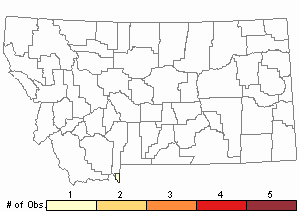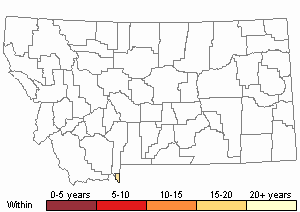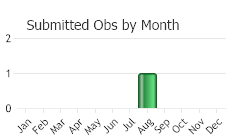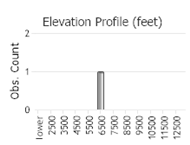View in other NatureServe Network Field Guides
NatureServe
Montana
Utah
Wyoming
Idaho
Wisconsin
British Columbia
South Carolina
Yukon
California
New York
Dwarf Sagebrush - Artemisia arbuscula ssp. arbuscula
General Description
PLANTS: Aromatic shrubs of 10–40 cm tall (Lesica et al. 2012) that sprout from roots (FNA 2006). Stems are gray-green to brown, brittle, and glabrate (FNA 2006). Plants are glabrate to tomentose, and sometimes with obscure resin dots beneath the tomentum (FNA 2006; Lesica et al. 2012).
LEAVES: Aromatic, gray-green, wedge-shaped (cuneate), 5–25 mm long, and tipped with 3 lobes (FNA 2006). Upper leaves are densely hairy (not sticky) (FNA 2006). Leaves on flowering stems are deciduous while those on non-flowering stems are persistent (FNA 2006).
INFLORESCENCE: Spiciform with linear bracts (Lesica et al. 2012).
In Montana we have subspecies arbuscula and longiloba (refer to Habitat, Phenology & Diagnostic Characteristics).
Phenology
Subspecies arbuscula flowers from mid- to late summer (FNA 2006), which in Montana is mid-August to September (Lesica et al. 2012).
Subspecies longiloba flowers from early to late spring (FNA 2006), which in Montana is from July to mid-August (Lesica et al. 2012). Its ability to begin blooming as snow melts in the spring is a unique characteristic for the subgenus Tridentatae (FNA 2006).
Diagnostic Characteristics
Refer also to Phenology.
Subspecies arbuscula has leaves with acute lobes and stiffly erect to ascending stems (Lesica et al. 2012). Leaves are broadly cuneate (lobes less than half the blade length, 1-3 mm wide, and rounded) (FNA 2006). The involucres are 3.5-4 mm tall and 2-4.5 mm in diameter (FNA 2006). Plants are found on stony calcareous soil (Lesica et al. 2012)
Subspecies longiloba has leaves with rounded lobes and flexuous, prostrate-spreading stems (Lesica et al. 2012). Leaves are broadly cuneate (4-10 mm by 2-5 mm, often irregularly lobed, with rounded lobes, and middle lobes overlapping lateral lobes) (FNA 2006). The involucres are 2-3 mm tall and 1.5-2.5 mm in diameter (FNA 2006). Plants are found on fine-textured soil of stream terraces (Lesica et al. 2012). Ecologically it is distinguished from other subspecies by growing at low elevations in fine-grained clay soils (FNA 2006).
Range Comments
In Montana subspecies arbuscula has been found in Beaverhead, Gallatin, Madison, and Park Counties (https://www.pnwherbaria.org). Its range includes California, Colorado, Idaho, Montana, Nevada, Utah, and Washington, Wyoming (FNA 2006).
In Montana subspecies longiloba has been found in Beaverhead, Madison, and Park Counties (MTNHP 2018 botany database). Its range includes California, Colorado, Idaho, Montana, Oregon, Utah, and Wyoming (FNA 2006).
Observations in Montana Natural Heritage Program Database
Number of Observations: 1
(Click on the following maps and charts to see full sized version)
Map Help and Descriptions
Relative Density

Recency



 (Observations spanning multiple months or years are excluded from time charts)
(Observations spanning multiple months or years are excluded from time charts)
Habitat
Subspecies arbuscula plants are found rocky sedimentary soils in high valleys and mountain slopes at elevations from 1500 to 3800 meters (FNA 2006). In Montana plants occur on stony calcareous soil (Lesica 2012).
Subspecies longiloba plants are found on clay soils of alkaline basins and valleys, occasionally on outwash plains of mountains, at elevations from 1500 to 2500 meters (FNA 2006). In Montana plants occur on fine-textured soil of stream terraces (Lesica et al. 2012).
Ecology
Greater Sage-grouse are known to eat Artemisia arbuscula ssp. arbuscula (Boyle and Reeder 2005).
Reproductive Characteristics
Artemisia arbuscula flowers (heads): The involucre is campanulate, about 2–5 mm high with green, tomentose phyllaries (Lesica et al. 2012). The receptacle is glabrous. Heads consist of 4-8 perfect (contains both male and female structures) disk flowers that are glabrous or glandular; Corolla is about 2 mm long (Lesica et al. 2012). Achenes are resinous and less than 1 mm long (Lesica et al. 2012).
The involucres for subspecies arbuscula are 3.5-4 mm tall and 2-4.5 mm in diameter (FNA 2006).
The involucres for subspecies longiloba are 2-3 mm tall and 1.5-2.5 mm in diameter (FNA 2006).
Stewardship Responsibility
References
- Literature Cited AboveLegend:
 View Online Publication
View Online Publication Boyle, S. A. and D. R. Reeder. 2005. Colorado sagebrush: a conservation assessment and strategy. Grand Junction: Colorado Division of Wildlife.
Boyle, S. A. and D. R. Reeder. 2005. Colorado sagebrush: a conservation assessment and strategy. Grand Junction: Colorado Division of Wildlife. eFloras. 2017. Flora of North America. Missouri Botanical Garden, St. Louis, MO & Harvard University Herbaria, Cambridge, MA.
eFloras. 2017. Flora of North America. Missouri Botanical Garden, St. Louis, MO & Harvard University Herbaria, Cambridge, MA. Flora of North America Editorial Committee. 2006. Flora of North America North of Mexico. Vol. 19. Magnoliophyta: Asteridae, part 6: Asteraceae, part 1. Oxford Univ. Press, New York. xxiv + 579 pp.
Flora of North America Editorial Committee. 2006. Flora of North America North of Mexico. Vol. 19. Magnoliophyta: Asteridae, part 6: Asteraceae, part 1. Oxford Univ. Press, New York. xxiv + 579 pp. Flora of North America Editorial Committee. 2006. Flora of North America North of Mexico. Vol. 20. Magnoliophyta: Asteridae, part 7: Asteraceae, part 2. Oxford Univ. Press, New York. xxii + 666 pp.
Flora of North America Editorial Committee. 2006. Flora of North America North of Mexico. Vol. 20. Magnoliophyta: Asteridae, part 7: Asteraceae, part 2. Oxford Univ. Press, New York. xxii + 666 pp. Lesica, P., M.T. Lavin, and P.F. Stickney. 2012. Manual of Montana Vascular Plants. Fort Worth, TX: BRIT Press. viii + 771 p.
Lesica, P., M.T. Lavin, and P.F. Stickney. 2012. Manual of Montana Vascular Plants. Fort Worth, TX: BRIT Press. viii + 771 p.
- Additional ReferencesLegend:
 View Online Publication
View Online Publication
Do you know of a citation we're missing? Culver, D.R. 1994. Floristic analysis of the Centennial Region, Montana. M.Sc. Thesis. Montana State University, Bozeman. 199 pp.
Culver, D.R. 1994. Floristic analysis of the Centennial Region, Montana. M.Sc. Thesis. Montana State University, Bozeman. 199 pp. Lesica, P., M.T. Lavin, and P.F. Stickney. 2022. Manual of Montana Vascular Plants, Second Edition. Fort Worth, TX: BRIT Press. viii + 779 p.
Lesica, P., M.T. Lavin, and P.F. Stickney. 2022. Manual of Montana Vascular Plants, Second Edition. Fort Worth, TX: BRIT Press. viii + 779 p.
- Web Search Engines for Articles on "Dwarf Sagebrush"





